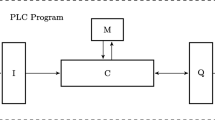Abstract
Model checking techniques are recognized to provide reliable and copious results. Instead of examining a few cases only – as it is done in testing – model checking includes the whole state space in mathematical proofs of correctness. Yet, this completeness is seen as a drawback as the state explosion problem is hard to handle. In our industrial case study, we apply automated model checking techniques to an innovative elevator system, the TWIN by ThyssenKrupp. By means of abstraction and nondeterminism, we cope with runtime behaviour and achieve to efficiently prove our specification’s validity. The elevator’s safety requirements are exhaustively expressed in temporal logic along with real-world and algorithmic prerequisites, consistency properties, and fairness constraints. Beyond verifying system safety for an actual installation, our case study demonstrates the rewarding applicability of model checking at an industrial scale.
Zusammenfassung
Model-Checking-Techniken liefern anerkanntermaßen zuverlässige und umfassende Ergebnisse. Im Gegensatz zu Testverfahren werden nicht nur Einzelfälle untersucht, sondern der gesamte Zustandsraum fließt in die mathematische Korrektheitsprüfung ein, was jedoch aufgrund schwer handhabbarer Zustandsexplosion als Nachteil angesehen wird. In unserer Industrie-Fallstudie, der Anwendung automatisierter Model Checking Techniken auf das innovative TWIN Aufzugssystem von ThyssenKrupp, beweisen wir die Gültigkeit der Spezifikation bezüglich der Anforderungen; Effizienz wird durch Abstraktion und Nichtdeterminismus erreicht. Die Sicherheitsanforderungen an den Aufzug sind vollständig in Temporallogik ausgedrückt, ebenso wie algorithmische und technische Voraussetzungen, Konsistenzbedingungen und Fairness-Eigenschaften. Unser Fallbeispiel weist nicht nur die Betriebssicherheit eines Produktivsystems nach, sondern unterstreicht die lohnende Anwendbarkeit von Model Checking Techniken im industriellen Maßstab.
Similar content being viewed by others
References
Bäumler S, Balser M, Dunets A, Reif W, Schmitt J (2006) Verification of Medical Guidelines by Model Checking – A Case Study http://spinroot.com/spin/Workshops/ws06/027.pdf
Bundesamt für Sicherheit in der Informationsgesellschaft (BSI) (2005) Common Criteria for Information Technology Security Evaluation, Part 3. http://www.bsi.de/cc/ccpart3v2_3.pdf
Burch JR, Clarke EM, Long DE (1994) Symbolic Model Checking for Sequential Circuit Verification. IEEE Trans Comp Aided Design Integr Circ Syst 13:401–424
Chan W, Anderson RJ, Beame P, Burns S, Modugno F, Notkin D, Reese JD (1998) Model checking large software specifications. IEEE Trans Softw Eng 24(7):498–520
Cimatti A, Clarke EM, Giunchiglia F, Roveri M (2000) NuSMV: a new symbolic model verifier. In: Halbwachs N, Peled D (eds) International Conference on Computer-Aided Verification (CAV’99), LNCS, vol 1633, pp 495–499, Springer, Berlin Heidelberg
Cimatti A (2000). Industrial Applications of Model Checking. In: Cassez F, Jard C, Rozoy B, Ryan MD (eds.) Modeling and Verification of Parallel Processes (MOVEP’00), LNCS, vol. 2067, pp 153–167, Springer, Berlin Heidelberg
Clarke EM, Grumberg O, Peled DA (1999) Model Checking. The MIT Press, Cambridge, MA, USA
Helke S, Kammüller F (2005) Property Preserving Abstraction for Statecharts. In: 25th IFIP WG 6.1 International Conference on Formal Techniques for Networked and Distributed Systems, FORTE 2005, LNCS, vol. 3731, pp 305–319, Springer, Berlin Heidelberg
Holzmann GJ (1991) Design and Verification of Computer Protocols. Prentice Hall, London
Janssen W, Mateescu R, Mauw S, Fennema P, van der Stappen P (1999) Model checking for managers. In: Proceedings Theoretical and Practical Aspects of SPIN Model Checking, LNCS, vol 1680, pp 92–107, Springer, Berlin Heidelberg
Lamport L (1994) The temporal logic of actions. ACM Trans Prog Lang Syst 16:872–923 http://doi.acm.org/10.1145/177492.177726
Larsen K G, Steffen B, Weise C (1997) Continuous Modelling of Real Time and Hybrid Systems: From Concepts to Tools. Int J Softw Tools Technol Transf 1:64–85
Manna Z, Pnueli A (1991) The Temporal Logic of Reactive and Concurrent Systems: Specification. Springer-Verlag, New York
McMillan KL (1992) Symbolic Model Checking – an Approach to the State Explosion Problem. School of Computer Science, Pittsburgh PA, Carnegie Mellon University
McMillan KL (1995) Symbolic Model Checking. Kluwer Academic Publishers, Norwell, MA, USA
nuSMV (1999) NuSMV examples: the collection. http://nusmv.irst.itc.it/examples/examples.html
Preibusch S (2006) http://preibusch.de/projects/TWIN/
ThyssenKrupp (2005) Safe distance – Four-level safety concept. http://twin-elevator.com/Safe_distance.353.0.html?L=1
ThyssenKrupp (2005) Higher performance. http://twin-elevator.com/New_buildings.368.0.html?L=1
Uppsala University, Department of Information Technology (2006) UPPAAL. http://www.uppaal.com/
Author information
Authors and Affiliations
Corresponding author
Additional information
CR subject classification
D.2.4; F.3.1; J.7 ; C.3
Rights and permissions
About this article
Cite this article
Kammüller, F., Preibusch, S. An industrial application of symbolic model checking . Informatik Forsch. Entw. 22, 95–108 (2008). https://doi.org/10.1007/s00450-007-0032-2
Received:
Accepted:
Published:
Issue Date:
DOI: https://doi.org/10.1007/s00450-007-0032-2




